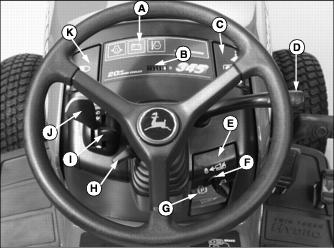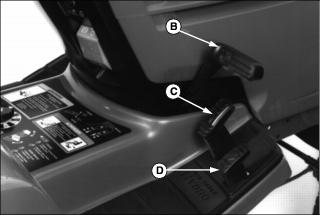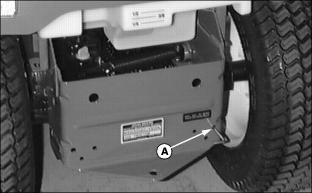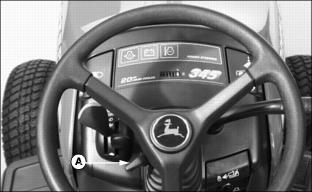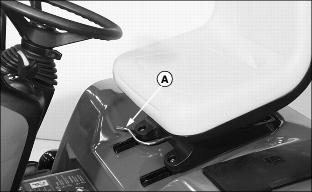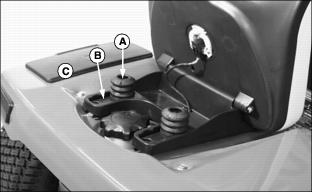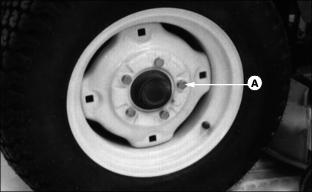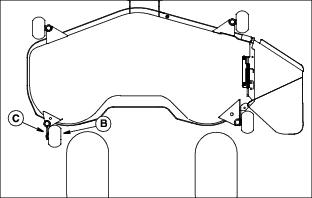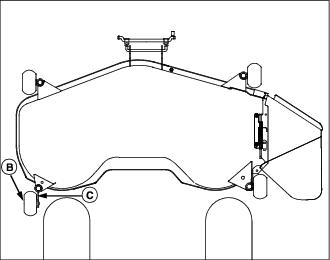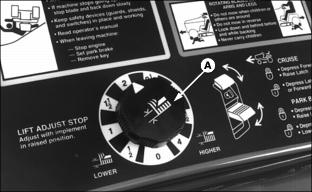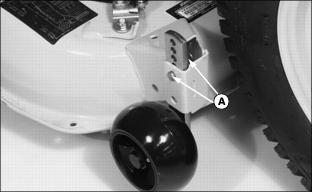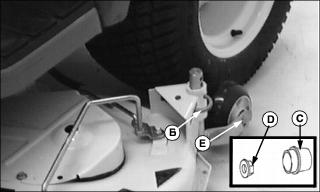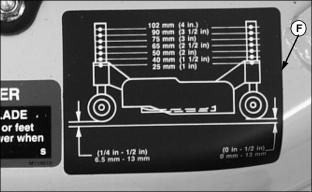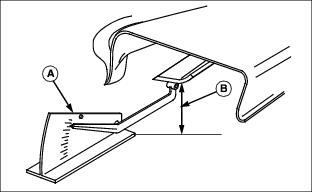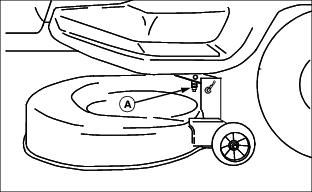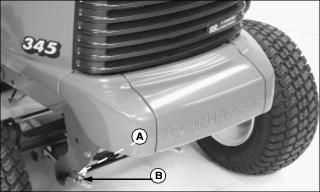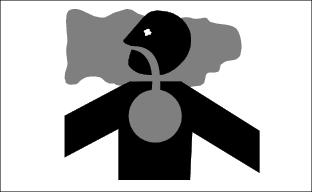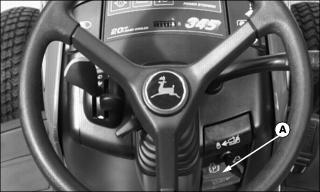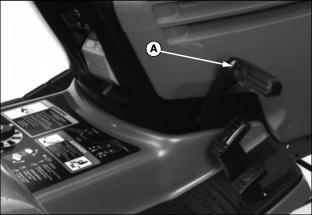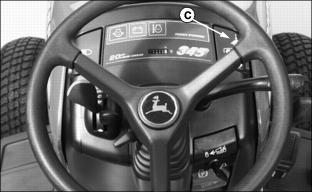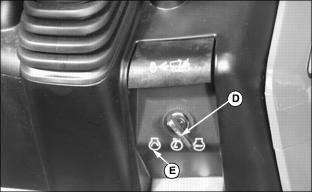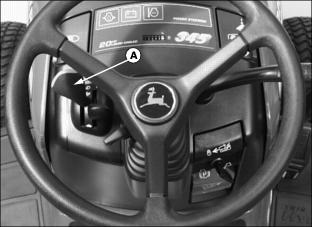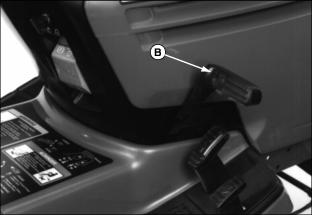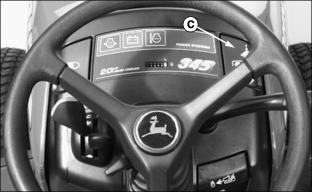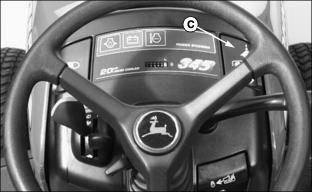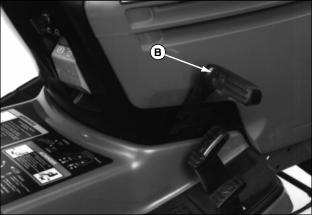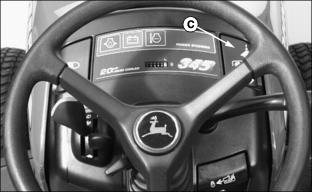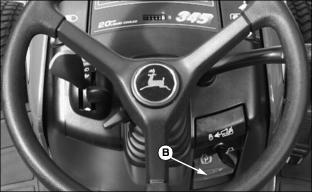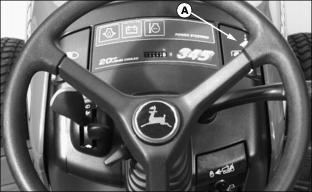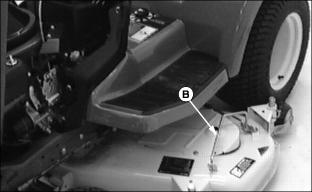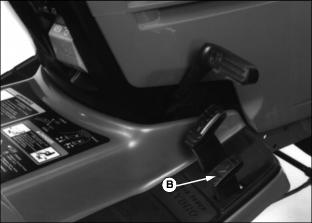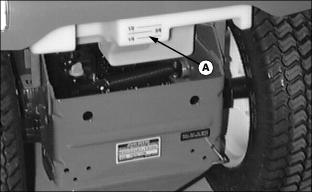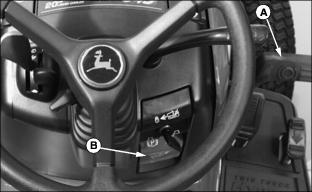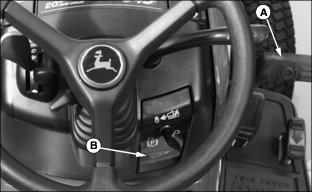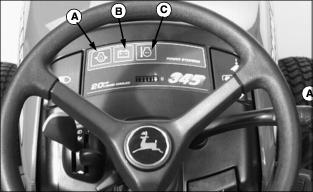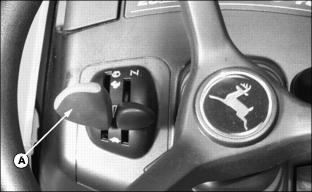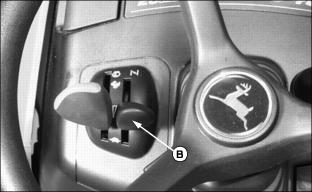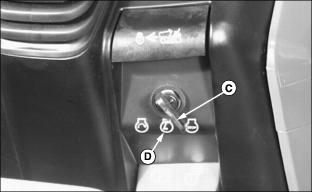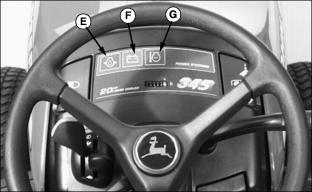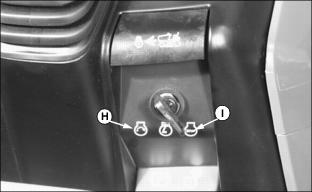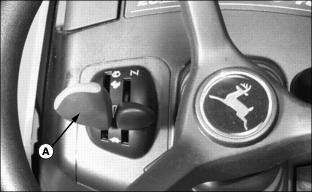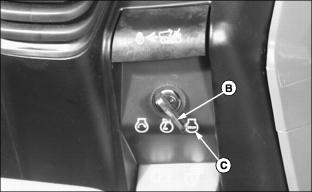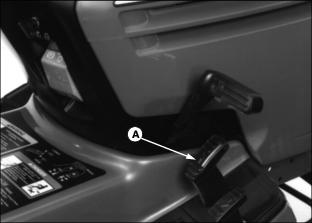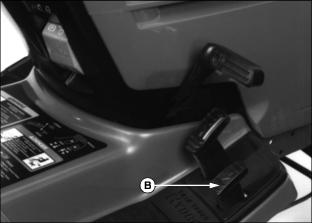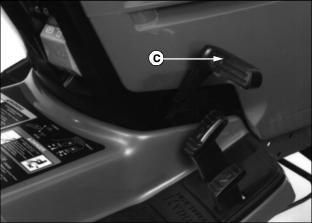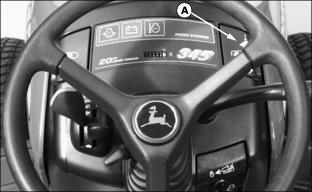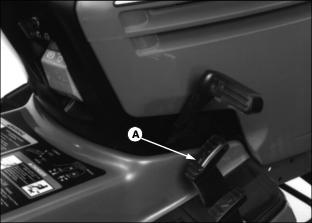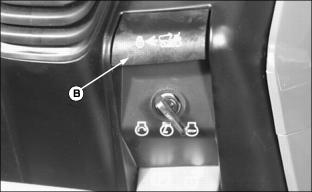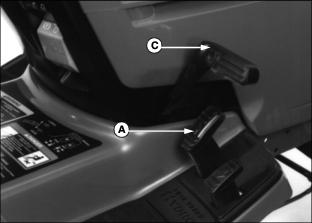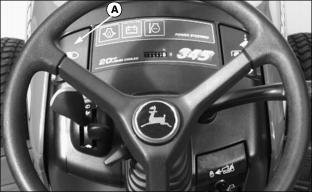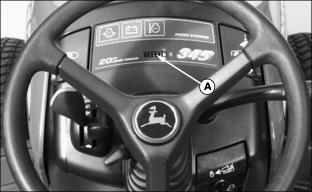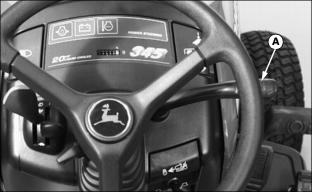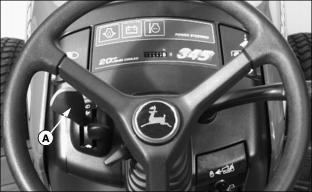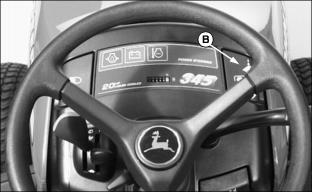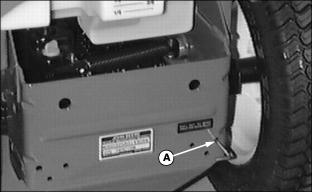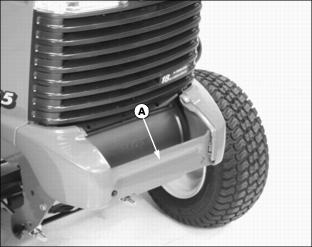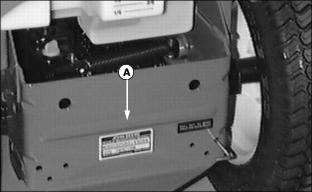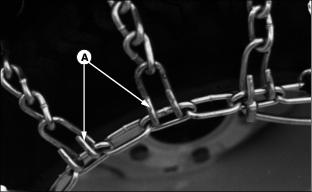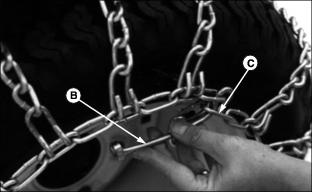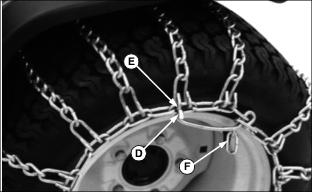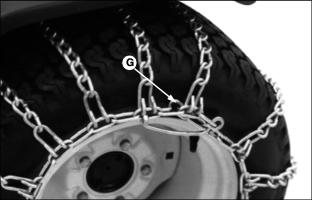Introduction
Product Identification
Safety
Operating
Avoid Damage to Plastic and Painted Surfaces
Adjusting Rear Wheel Spacing (Tractor With 54-Inch Mower Deck Only)
Adjusting Mower Level (Side-to-Side)
Adjusting Mower Level (Front-to-Rear)
Testing Reverse Implement Option
Using The Reverse Implement Option
Using PTO (Engaging and Disengaging Mower)
Unplugging Mower or Optional Bagger
Transporting Machine on Trailer
Replacement Parts
Service Intervals
Service Lubrication
Service Engine - Models 325 and 335
Service Engine - Model 345
Service Transmission
Service Steering & Brakes
Service Mower
Service Electrical
Service Miscellaneous
Troubleshooting
Storage
Assembly
Specifications
Warranty
John Deere Quality Statement
Service Record
CopyrightŠ Deere & Company

Operating
Daily Operating Checklist
o Check transmission oil level.
o Check coolant level on liquid cooled engine.
o Remove grass and debris from machine.
o Check area below machine for leaks.
Avoid Damage to Plastic and Painted Surfaces
ˇ Do not wipe plastic parts unless rinsed first.
ˇ Insect repellent spray may damage plastic and painted surfaces. Do not spray insect repellent near machine.
ˇ Be careful not to spill fuel on machine. Fuel may damage surface. Wipe up spilled fuel immediately.
Operator Station
C - PTO Switch / Reverse Implement Option
Miscellaneous Controls
Adjusting Tilt Steering Wheel
ˇ Make sure steering wheel is LOCKED in position before operating machine. |
Steering wheel has five tilt positions:
ˇ Pull lever (A) down and push or pull wheel to a comfortable operating position.
ˇ Push lever up to lock wheel in position.
Adjusting Seat
To adjust seat position:
1. Push lever (A) to the left.
2. Slide seat forward or rearward to desired position.
To adjust seat for ride comfort:
IMPORTANT: Avoid damage! To prevent damage to seat switch, seat base and fuel tank, DO NOT operate without suspension coils in place. |
Lift seat, unscrew and move springs to desired position as follows:
ˇ Install both springs into front position (A) for softest ride.
ˇ Install both springs into middle position (B) for average ride.
ˇ Install both springs into rear position (C) for firm ride.
Adjusting Rear Wheel Spacing (Tractor With 54-Inch Mower Deck Only)
1. Park machine safely on a level surface. (See Parking Safely in the SAFETY section.)
2. Put blocks in front and back of front wheels.
3. Loosen five rear wheel bolts (A). Lift rear wheels off the ground with floor jack or hoist.
5. Install wheels in the wide position as follows:
ˇ Turf Tires: Install wheel on same side of tractor with valve stem on the inside.
ˇ Bar Tires: Install each wheel on opposite side of tractor. Bars on tires must point forward.
6. Tighten wheel bolts to 88 Nˇm (65 lb-ft).
7. Lower rear wheels to the ground. Remove blocks from front wheels.
Picture Note: Gage wheel to the inside of bracket when tractor tires are in the narrow (shipped from factory) position.
Picture Note: Gage wheel to the outside of bracket when tractor tires are in the wide position.
8. Move left hand rear gage wheel (B) to the outside of gage wheel bracket (C) to allow for clearance of the rear tractor tire.
NOTE: Once the left rear gage wheel is moved to the outside, it cannot be turned 90 degrees for deck removal.
Adjusting Cutting Height
NOTE: Raise mower as high as it will go before turning height control knob.
Cutting height can be adjusted from approximately 13-113 mm (1/2-4-1/2 in.).
1. Pull back hydraulic control lever to raise mower as high as it will go.
2. Turn mower height control knob (A) to desired cutting height. Mower will be at that cutting height when it is lowered.
Adjusting Mower Deck Wheels
1. Park machine safely. (See Parking Safely in the Safety Section).
2. Inflate tires to the correct pressure.
3. Raise lift lever to transport position and adjust cutting height.
4. Move lift lever to mowing position.
NOTE: Bottom of wheels should be approximately 6-13 mm (1/4-1/2 in.) from the ground.
5. Check mower wheel position. Move mower wheels to proper hole.
ˇ 48C Mower Deck: Remove spring locking pin and drilled pin (A).
Pull out spring loaded J-pin (B).
On Left Rear Wheel: Remove plastic cap (C) and loosen nut (D), move left rear wheel up or down in slot (E) to match height of right rear wheel. Tighten nut and install plastic cap.
NOTE: Adjust wheels by 13 mm (1/2 in.) move wheel up or down one hole. Use decal (F) located on top of deck.
6. Move all wheels to the same height and secure with pins to lock wheels in position.
Adjusting Mower Level (Side-to-Side)
NOTE: Mower wheels should not contact the ground when leveling the deck.
1. Park machine safely on a level surface. (See Parking Safely in the SAFETY Section).
2. Inflate tires to the correct pressure.
3. Adjust cutting height to 50 mm (2 in).
4. Push hydraulic lift lever forward to lower mower as far as it will go.
NOTE: The difference between blade measurements must not be more than 3 mm (1/8 in).
5. Turn left blade parallel to axle and complete measurement. Hold drive belt and turn right blade parallel to machine axle and complete measurements.
Picture Note: A convenient leveling gauge (A) is available from your John Deere dealer.
6. Measure from each outside blade tip (B) to the level surface.
NOTE: Cutting height can closely match knob setting by adjusting lift links on both sides of deck.
Picture Note: Left side shown.
7. Adjust lift links, turn nut (C):
ˇ Clockwise to raise left side of mower.
ˇ Counterclockwise to lower left side of mower.
Adjusting Mower Level (Front-to-Rear)
NOTE: Mower wheels should not contact the ground during leveling.
1. Park machine safely on a level surface. (See Parking Safely in the SAFETY Section).
2. Inflate tires to the correct pressure.
3. Adjust cutting height to 50 mm (2 in).
4. Lower mower as far as it will go using hydraulic control lever.
5. Turn right blade so blade tip points straight forward.
6. Measure from the front of blade tip to the level surface. The front blade tip must be 3-6 mm (1/8-1/4 in) lower than rear blade tip.
7. Loosen two rear nuts (A) on adjusting bolts and turn two front nuts (B) clockwise to raise front of mower deck or counterclockwise to lower front of mower deck.
8. Tighten rear nuts after adjustment is completed.
Testing Safety Systems
Use the following checkout procedure to check for normal operation of machine.
If there is a malfunction during one of these procedures, Do not operate machine. See your John Deere dealer for service.
Perform these tests in a clear open area. Keep bystanders away.
Testing Park Brake Switch
2. Unlock park brake (A). Release brake pedal.
Model 345: Coolant light should come on.
Testing PTO Switch
1. Depress brake pedal (A), or lock park brake.
3. Turn key (D) to start position (E).
Testing Seat Switch
ˇ Move throttle lever (A) up to maximum engine speed.
ˇ Unlock park brake and release brake pedal (B).
ˇ Raise up off seat. Do Not get off tractor.
ˇ Engine should begin to die. PTO should shut off immediately and mower blades should stop.
ˇ Unlock park brake and release brake pedal (B).
ˇ Raise up off seat. Do Not get off tractor.
ˇ Raise up off seat. Do Not get off tractor.
ˇ Engine should continue to run.
Testing Mower Blade Stop Time
NOTE: This test should be performed once a year or every 100 hours.
Perform this test while sitting on the tractor.
3. Watch left-hand side mower spindle (B). disengage PTO, mower spindle should stop turning within 5 seconds.
4. If spindle does not stop within 5 seconds, the PTO brake needs servicing. (See your John Deere dealer for this service.)
Testing Reverse Implement Option
2. Engage PTO (A) to start attachment.
3. Look behind the vehicle to be sure there are no bystanders.
4. Begin reverse travel by depressing reverse foot pedal (B).
5. Attachment should stop operation. If attachment continues to operate while tractor travels in reverse, do not continue to operate attachment. See your John Deere dealer for service.
Checking Fuel Level
Check fuel level according to marks (A) on tank.
Using the Park Brake
ˇ Always LOCK park brake before getting off tractor or leaving tractor unattended. |
Lock Park Brake
1. Push and hold brake pedal (A) all the way down.
2. Pull red park brake lever (B) up to lock park brake.
3. Release pedal and park brake lever. Pedal should stay down and park brake lever should stay up in locked position.
IMPORTANT: Avoid damage! To avoid transmission damage, be sure to UNLOCK park brake before using travel pedals. |
Unlock Park Brake
1. Push and hold brake pedal (A) all the way down.
2. Push park brake lever (B) down.
3. Release pedal. Pedal should come up to operating position.
Checking Indicator Lights
A - Oil Pressure Indicator Light - will come on when you turn the key to the run position. Indicator should go out when engine is started. If indicator comes on during operation, engine oil pressure is too low. Stop engine and perform appropriate service.
B - Battery Discharge Indicator Light - will come on when you turn the key to the run position. Indicator should remain on during starting cycle. If indicator comes on during operation, stop engine and perform appropriate service.
C - Model 345 Only: Coolant Temperature Indicator Light - will not come on when you turn the key to the run position. If indicator comes on during operation, coolant temperature is above normal operating temperature. Stop engine and perform appropriate service. Coolant light will come on momentarily when key is turned to the start position.
Starting the Engine
NOTE: You must hold brake pedal down, or lock park brake, before you can start the engine. PTO switch must be off.
1. Lock park brake or depress brake pedal.
2. Position throttle lever (A):
NOTE: Choke lever is spring loaded. Push lever to the choke position when starting. Release lever after engine starts and lever will return by itself.
4. Turn key (C) to the run position (D).
ˇ Oil Pressure indicator (E) will come on.
ˇ Battery Discharge indicator (G) will come on.
ˇ Model 345: Coolant temperature indicator (F) will come on.
NOTE: In temperatures 0° C (32° F) it may be necessary to repeat this step 3 to 5 times before engine will start.
6. Turn key to the start position (H):
ˇ If engine does not start within 5 seconds, turn key to stop position (I) and wait 10 seconds.
ˇ Crank engine again for 5 seconds.
7. As soon as engine starts, release key. The key will return to the run position and all indicator lights should be off. If a light does not go off, stop engine and perform appropriate service. Release choke lever and put throttle lever in the appropriate position.
Stopping the Engine
2. Pull throttle lever (A) down to the slow position. Let engine reach low idle speed for a few seconds.
3. Turn key (B) to STOP position (C).
4. Lock park brake. Remove key.
Using Travel Controls
ˇ Before moving forward or rearward, make sure area is clear of bystanders, especially children. |
Travel Forward
2. Slowly push down forward pedal (A). Tractor will travel faster the farther down you push the pedal.
3. Release forward pedal, tractor will automatically return to neutral and stop.
Travel in Reverse
NOTE: Any operating attachment will stop as the reverse foot pedal is depressed with attachment engaged.
1. Bring the vehicle to a stop.
2. Push PTO knob down to the off position to disengage attachment.
3. Look behind the vehicle to be sure there are no bystanders nearby.
4. Push down reverse pedal (B).
Emergency Stopping
1. Release either travel pedal, tractor will automatically return to neutral and stop.
2. Push down on brake pedal (C). Tractor brakes will be applied to assist in stopping.
Using The Reverse Implement Option
NOTE: Operating the mower while backing up is strongly discouraged. The Reverse Implement Option should be used ONLY when operating another attachment or when the operator deems it necessary to reposition the machine with the mower engaged.
1. Stop the machine forward travel with attachment engaged.
2. Look behind the vehicle to be sure there are no bystanders.
3. Lift and hold the PTO knob (A) up past the PTO engagement position to activate the reverse implement position while depressing reverse foot pedal slightly.
NOTE: If the attachment stops while repositioning the machine, return PTO knob to the OFF position. Begin again with Step 2 in procedure.
4. As the machine begins to move backward, release the PTO knob and reposition the machine.
5. Resume forward travel. If the attachment stops, return the PTO knob to the off position and engage the PTO again.
6. Repeat Steps 1 through 5 to reposition the machine again.
Using Cruise Control
DO NOT use cruise control when going down hills. Operate tractor in a large, open area to learn how the cruise control works. |
Use cruise control when you want to maintain travel speed without having to hold the forward travel pedal down. Cruise control operates only for forward travel.
Engage Cruise Control
1. Push forward pedal (A) down until you reach desired travel speed.
2. Pull and hold lever (B) up to engage the cruise control.
3. Remove foot from forward pedal.
Disengage Cruise Control
NOTE: The cruise control can be disengaged using any one of the three following steps.
ˇ Push forward pedal (A) down OR
ˇ Push brake pedal (C) down OR
ˇ Push cruise control lever down.
NOTE: Cruise control will not disengage if reverse travel pedal is depressed.
Using Lights
ˇ Pull up on light handle (A) to turn lights on.
ˇ Push down on handle (A) to turn lights off.
Using Hour Meter
The hour meter (A) shows the number of hours the engine has run and runs anytime key is in the run position.
Check the hour meter daily and service your machine according to Service Intervals section.
Using Hydraulic Control Lever
NOTE: Do not use hydraulic control lever to adjust cutting height. Use height control dial to determine cut height.
Using control lever (A) with a mower deck:
ˇ Pull and hold lever back until mower deck is raised.
ˇ Push lever forward to lower the mower deck.
Hydraulic control lever is also used to raise and lower other attachments such as a snowthrower or blade. (Refer to attachment operator manual for instructions on how to use lever with attachment.)
Using PTO (Engaging and Disengaging Mower)
1. Start engine and allow it to idle for two to three minutes.
NOTE: Always operate engine at fast speed when PTO is engaged.
2. Move throttle lever (A) fast speed position.
3. Move PTO switch (B) to desired position.
ˇ To engage PTO: pull up on switch lever to position "I".
ˇ To disengage PTO: push down on switch lever to Position "O".
ˇ To keep PTO engaged while the tractor is in reverse: lift switch lever fully to position ".
Pushing Machine
IMPORTANT: Avoid damage! Transmission damage may occur if the machine is moved or towed incorrectly: |
2. Pull out on free-wheeling lever (A).
3. Push tractor to desired location.
NOTE: Lever will automatically return to the operating position when you push down the brake pedal.
Unplugging Mower or Optional Bagger
ˇ Park the machine safely and lock the park brake before getting off the seat. |
3. Move throttle lever to slow position.
8. Wait for all moving parts to stop.
Transporting Machine on Trailer
Be sure trailer has all the necessary lights and signs required by law.
IMPORTANT: Avoid damage! Transmission damage may occur if the machine is moved or towed incorrectly: |
1. Drive forward onto heavy-duty trailer.
2. Lower mower to trailer deck.
4. Fasten lawn tractor to trailer with heavy-duty straps, chains, or cables. Both front and rear straps must be directed down and outward from tractor.
Using Weights
Install tractor front weights to improve stability when operating on slopes.
See your John Deere dealer for the correct weights. Follow instructions provided with weights to install on your machine.
Front Frame Weights
Install front weights for better stability and steering control when you use equipment such as the rear-mounted grass bagger or dump cart. The plastic front bumper cover can be removed so front suitcase weights can be used.
A front frame weight weighs 19 kg (42 lbs.).
Remove the plastic front bumper cover. (See Removing/Installing Front Bumper in the SERVICE - MISCELLANEOUS section.)
Install weights as necessary on front frame (A).
(See your John Deere dealer for weights.)
Front Wheel Weights
NOTE: Before installing wheel weights on your tractor, MAKE SURE that the tire valve stems are facing to the inside.
Each wheel weight weighs 16 kg (35 lbs). Two front wheel weights and mounting kit are required. (See your John Deere dealer for kit and weights.)
Remove front wheel weights when not required.
Wheel and Frame Rear Weights
The rear hitch plate (A) holds four suitcase weights. Use of these weights is recommended when an attachment, such as snowthrower or blade is used. (See your John Deere dealer for weights.)
Installing Tire Chains
IMPORTANT: Avoid damage! Loose tire chains can cause machine damage. Periodically check chain tightness and adjust as necessary. |
NOTE: Chains are available from your John Deere dealer.
1. Park machine safely. (See Parking Safely in the Safety Section.)
2. Lay chains out flat with the cross chain hook ends facing downward.
3. Remove any twists and tangles from cross chain and rim chain.
5. Drape chain over tire with the lever fastener on outside of tire and cross link hooks (A) facing upward and away from tire.
6. Adjust chain for straightness and an even amount of cross chain links on each side of tire.
7. Place the first cross chain (opposite the end with fastener and inside hook) under tire.
8. Pull the inside rim chain tight and hook the inside hook.
9. Pull the outside rim chain tight and hook the outside lever fastener (B) by running the end through a free link (C).
10. Close the fastener by rotating it back 180 degrees and engaging the hook (D) on the end of the fastener into a rim chain link (E).
Make sure the chain is centered on the tire with approximately the same number of free rim links (F) on the inside and outside.
NOTE: The chain should be as tight as possible. If chain is loose, unhook the fastener and pull chain tight again.
11. Tie excess rim chain links (G) back to the rim chain.
12. Drive forward on chains 9-12 m (30-40 ft.) and recheck for tightness. Adjust as necessary.
Using Correct Blades
NOTE: See Replacement Parts section for part numbers.
ˇ Standard Blades - Standard blades are designed for bagging, side discharging and all mowing conditions.
ˇ Mulching Blades - Mulching blades are to be used with the optional Mulch Kit.
ˇ Standard Blades - Known as "Cut Performance" blades. Good for all standard mowing conditions.
ˇ Optional Blades - Known as "Discharge Performance" and "High Lift" blades. These blades have a slightly higher lift (increased air flow) and may improve performance in wet or lush conditions
ˇ Mulching Blades - Mulching blades are to be used with the optional Mulch Kit.
Mowing Tips
The following recommendations will produce the best lawn cut quality and appearance:
ˇ Keep mower blades sharp. Dull blades will tear grass; tips of grass will then turn brown.
ˇ Cutting grass too short may kill grass and let weeds grow easily.
ˇ Adjust cutting height to remove only 1/3 of the grass at a time.
ˇ Mow grass often. Short grass clippings will decay quickly.
ˇ Mow with engine at full throttle.
ˇ Adjust travel speed to match mowing conditions:
ˇ Travel at SLOW speed when you mow thick, tall grass, make sharp turns or trim around objects.
ˇ Travel at MODERATE speed when you mow thin grass.
ˇ Use a different mowing pattern each time you mow. Overlap mowing paths 50 to 100 mm (2 to 4 in).
ˇ Drive over ridges and through shallow ditches straight-on, not at an angle.
ˇ A thick layer of mulched leave can prevent sunlight from getting to grass and smother it. Taller grass heights allow mulched leaves to dispense easier in lawn. Mulch leaves several times if needed.
ˇ Use a thatcher in late spring or summer to pull up dead grass and aerate ground.

